15 Steps for a Successful Small Business CRM Implementation

To manage your business effectively, you need a groupware application, CRM system. Software designed to assist a group of people in an organization to work together is known as groupware. With a CRM system, everyone in the business can remember what the planned activities of the organization are primarily those that are involved with the clients directly because it enables them to understand their customers on a specific manner. This is paramount as it prevents miscommunication with the customers due to lack of communication within an organization.
With CRM system workers can understand the state of any problem currently, all client’s interactions are recorded and identify sales opportunities. What’s essential having some records of all the new leads regarding the business and track of promising leads promotes new opportunities.
The possibilities are recorded with an expected business close date, current stage of the opportunity sales cycle and the likelihood percentage of closing the business which is assigned to the opportunity. This insight is spread across the company as it shows a clear view of sales pipeline of the business. Individual data are aggregated so that it may help build a visual chart of the information.
The opportunities are classified by lead source, salespersons or expected the close date, and this ensures smooth performance of the activity. Having a correctly implemented CRM system, that is used by all the staff that is directly or indirectly facing customers provides easy tracking helps in tracking the sales performance of your organization smoothly with minimal work. This also helps in planning effectively as you can see the future more clearly.
CRM can be a tool that ties your business insight s together just like the customer focus ties all the business activities together especially with integration with other businesses systems like the public website. Other than that, another key area where CRM system comes in handy is in building customer communications. Furthermore, CRM can identify all your customers, holds all the vital marketing information and receive or receive emails from the customers.
15 Steps for a Successful Small Business CRM Implementation?
For successful CRM implementation, there is one significant attribute that you ought to understand even before you go into specifics. The factors consist of frequent and open collaboration and communication. Stakeholders will significantly be affected by the new CRM system thus they should be involved in the selection, development, and delivery of the system.
A crucial factor on successful CRM implementation is that the execution should manage the project well through realistic goals, view the entire process as a continual improvement not as a onetime process and implementation should be phased in modest steps.
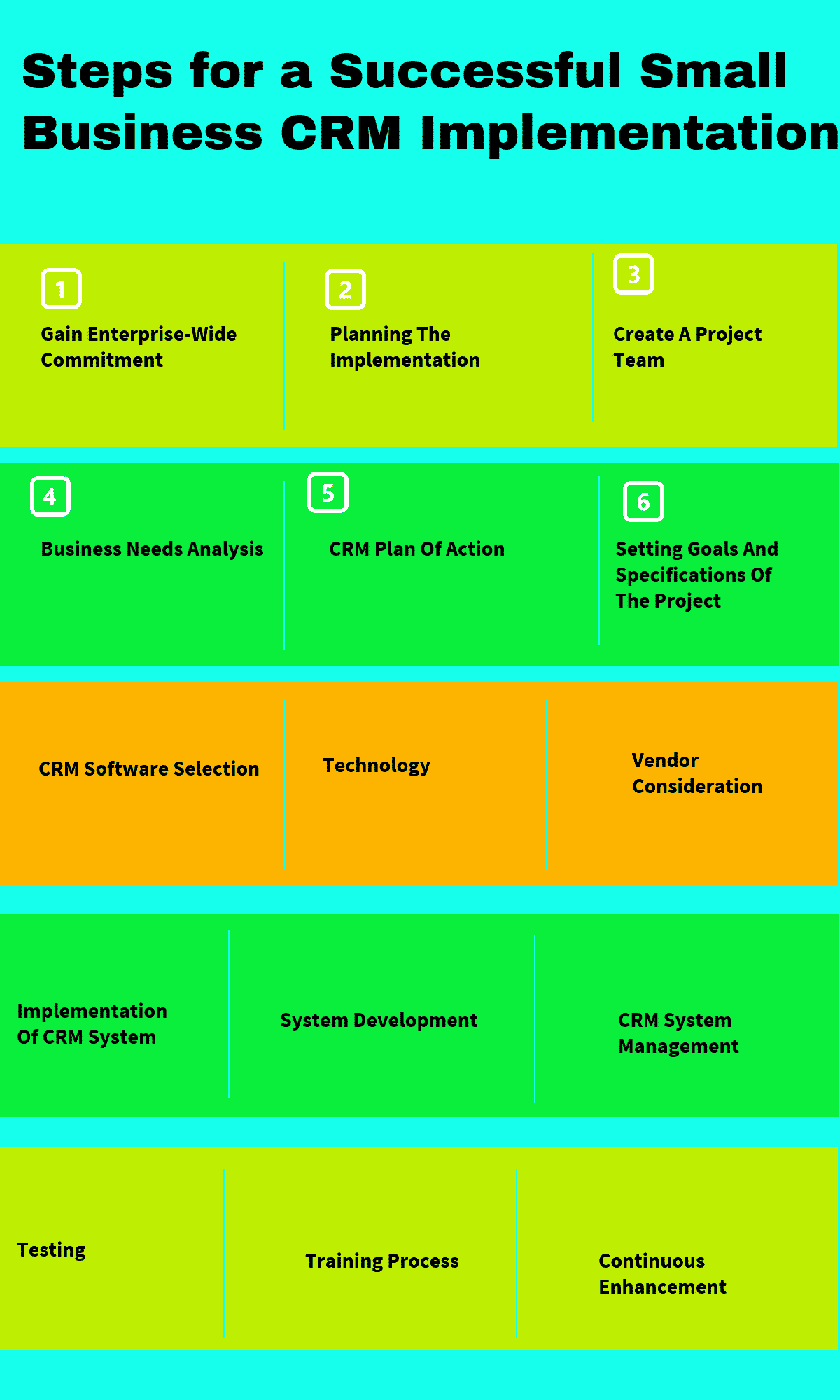
Steps for a Successful Small Business CRM Implementation
- STEP 1: Gain Enterprise-Wide Commitment
Before beginning any project, you must identify the problem on which the project is going to solve. Implementation of a CRM system needs an extensive collection of experts and talent. This is important as CRM involves several areas of business, thus its crucial to get support from all the departments: finance, manufacturing, sales, marketing, support, etc. It is through the involvement of the various department you gain credible insights before a system is implemented promoting acceptance and cooperation of the new system.
- STEP 2: Planning The Implementation
This step involves strategic planning of the implementation process of the new CRM system. You need the people and business part of this equation to work out correctly. You need to understand that the CRM implementation is being undertaken due to some shortcoming and the selected solution best addresses them. For better implementation, the project manager shouldn’t be contracted but someone familiar with the enterprise.
On this step, the user should agree on the potential technology solution, what should be done and specific vendor for customization that is within the scope of the project. The project manager should outline what the current perceived shortcomings in business processes, solution, proposed timeline and the technology that would be used are. The next step would be creating a project team.
- STEP 3: Create A Project Team
Once the planning has been outlined the next step would be the selection of the project team. This step is very crucial as the team would be the CRM effort nucleus making recommendations and decisions and ensure communication of CRM program benefits and details to the entire business.
To have a competent project team ensure that you include all the active representatives from each department from the top management, technical, sales and marketing, and finance. The team members of the selected department will represent desired outcomes for the chosen CRM system.
- STEP 4: Business Needs Analysis
For any success in CRM project, there is a need for analysis of the business needs. In most cases, the project team skip the assessment of the current processes and directly move to the CRM initiative technology without determining what needs automation.
In this phase, a couple of sessions are conducted to canvass customer service managers, top sales, and marketing relating the need for the CRM system. Collectively define the objectives, how the CRM will impact each department and CRM essential goals. The benefit of this phase is to conceptualize the company CRM solution.
- STEP 5: CRM Plan Of Action
Once you have conceptualized the ideal CRM system, the next phase would be Plan of Action. This implies the process needed in detail on how you will convert your CRM vision into a reality. In this phase, several determining factors need to be considered that might extend beyond the CRM specification.
First, begin by searching for CRM solution in the industry. The industry has several analysts whose central responsibility reviews and CRM research. Next, prioritize and develop CRM requirements by evaluating by inputting all the user's group.
- STEP 6: Setting Goals And Specifications Of The Project
In this phase, the project team should suggest project goals concerning business processes and the way in which they should be improved. There should be a proposed timeline for the phase of the implementation process. One of the project members should be documented on the suggested project goals in details, which will be agreed and presented later. The approach ensures that the business requirements are addressed first and identification of the leading CRM technology that can be used in the project.
- STEP 7: CRM Software Selection
The goal in selecting your CRM software is o promote and support customer service process and optimization of sales and marketing. This implies the selection of the software should be based on the knowledge of your organization infrastructure, functional requirements and the current technology.
There are a couple of dynamic segments of the comprehensive CRM software which provide the needed tools that would manage the interaction mechanisms that the customers can use to communicate with the organization. Ensure that each vendor has demonstrated as you investigate each potential vendor capabilities of the product and services
- STEP 8: Technology
To ensure success on your CRM project, technology ought to be employed smart. This is because there is no “one size fits all” in CRM, as there isn’t a possibility where two different companies are alike. The enabling technology should demonstrate the difference that is inherited to each business.
It's paramount that the chosen technology is open, customizable and able to integrate smoothly with the computing infrastructure that is existing in the organization. There are several features that you should take into consideration when selecting the CRM system technology: the toolset, database support, synchronization of data, web technology, security, and real-time integration.
- STEP 9: Vendor Consideration
When selecting suitable CRM software, the selection of software vendor is considered as a crucial process. The primary element of choosing a vendor is CRM experience. With the automation of business processes, every company is implementing a CRM solution in their organization.
The project team should research a vendor who has proven track record, years of experience and will be in business in long-term to offer support. Selecting an easy to communicate vendor, responsive to requests and business needs and one who has vast experience is essential because it shows that the vendor will provide adequate support and be with you through your CRM system life.
- STEP 10: Implementation Of CRM System
Commitment to the implementation of the CRM ensures its success. Several strategic phases facilitate successful implementation of the CRM system: planning, analysis, configuration, testing, roll-out, and support. If the stages are followed accordingly, there would be a smooth implementation of the CRM system in the organization
- STEP 11: System Development
In this phase, each of the new function-cluster is introduced to the team for evaluation, which is conducted one at a time. Once the assessment has been performed acceptance testing follow on the function-cluster as the implementation team focus on it ensuring its evaluated as needed. Once that has been accomplished the CRM application is installed on the organization servers’ hardware.
- STEP 12: CRM System Management
Performance measurement of the CRM infrastructure is essential, as it captures the data which is appropriate and allows access to appropriate individuals. Test the system before you roll-out to the users, and this ensures that the system would generate the needed benefits.
Modify the toolset if the system doesn’t perform to your satisfaction until it does. The project team should get feedback from the system as the information can provide insights on new opportunities, what’s working to leverage your investment in technology.
- STEP 13: Testing
Each of the section of the CRM should be tested thoroughly by the users that are significantly dependent on the section. Admin should examine the management of reports; sales test the pipeline charts and commission reports, accounts, contracts by the finance.
The testing ensures that the system is working to satisfaction and accuracy to the desired business processes.
- STEP 14: Training Process
The training process is vital in CRM implementation as it enables users to understand and familiarize with the system. This generates positive enthusiasm to the user base and momentum for the implementation. The project team should ensure that the management is trained on the how to use the system, making adjustments and control of issues.
- STEP 15: Continuous Enhancement
Continuous enhancement and evaluation are essential in every CRM system implementation. When your business evolves so should your CRM system. Every once in a while, your CRM system should be reviewed to achieve a high level of user satisfaction and perform potential improvements.
There are new opportunities on customer relation and satisfaction that are developing thus there is a need of continuous enhancement to ensure the system meets the desired goals.
What are the Steps for a Successful Small Business CRM Implementation?
A crucial factor on successful CRM implementation is that the execution should manage the project well through realistic goals, view the entire process as a continual improvement not as a onetime process and implementation should be phased in modest steps. The Steps for a Successful Small Business CRM Implementation are Gain Enterprise-Wide Commitment, Planning The Implementation, Create A Project Team, Business Needs Analysis, CRM Plan Of Action, Setting Goals And Specifications Of The Project and many more.

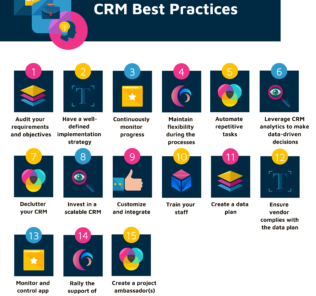

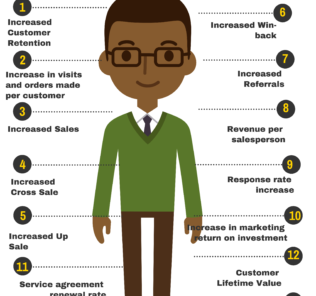
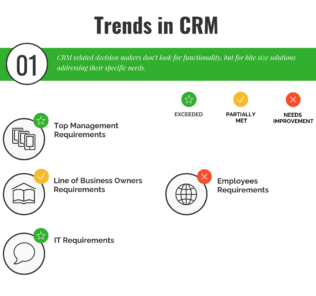
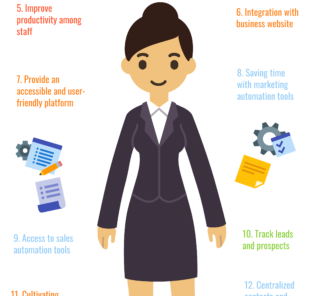
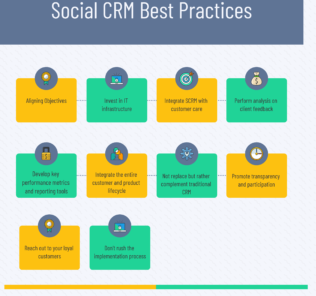




By clicking Sign In with Social Media, you agree to let PAT RESEARCH store, use and/or disclose your Social Media profile and email address in accordance with the PAT RESEARCH Privacy Policy and agree to the Terms of Use.